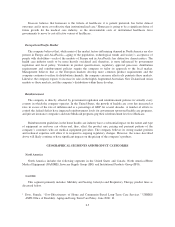Invacare 2011 Annual Report Download - page 20
Download and view the complete annual report
Please find page 20 of the 2011 Invacare annual report below. You can navigate through the pages in the report by either clicking on the pages listed below, or by using the keyword search tool below to find specific information within the annual report.In the U.S., the growth of health care costs has increased at rates in excess of the rate of inflation and as a
percentage of GDP for several decades. A number of efforts to control the federal deficit have impacted
reimbursement levels for government sponsored health care programs and private insurance companies often
imitate changes made in federal programs. Reimbursement guidelines in the home health care industry have a
substantial impact on the nature and type of equipment an end user can obtain and thus, affect the product mix,
pricing and payment patterns of the company’s customers who are the HME providers.
The company continues its pro-active efforts to shape public policy that impacts home and community-
based, non-acute health care. The company is currently very active with federal legislation and regulatory policy
makers. Invacare believes that these efforts give the company a competitive advantage in two ways. First,
customers frequently express appreciation for the company’s efforts on behalf of the entire industry. Second,
sometimes the company has the ability to anticipate and plan for changes in public policy, unlike most other
HME manufacturers who must react to change after it occurs.
The United States Food and Drug Administration (the “FDA”) regulates the manufacture and sale of
medical devices. Under such regulation, medical devices are classified as Class I, Class II or Class III devices.
The company’s principal products are designated as Class I or Class II devices. In general, Class I devices must
comply with labeling and record keeping requirements and are subject to other general controls. In addition to
general controls, certain Class II devices must comply with product design and manufacturing controls
established by the FDA. Domestic and foreign manufacturers of medical devices distributed commercially in the
U.S. are subject to periodic inspections by the FDA. Furthermore, state, local and foreign governments have
adopted regulations relating to the design, manufacture and marketing of health care products.
In December 2011, the FDA requested that the company negotiate and agree to a consent decree of
injunction at the company’s corporate facility and its wheelchair manufacturing facility in Elyria, Ohio, the
proposed terms of which would require the suspension of certain operations at those facilities until they are
certified by the company and then determined by FDA to be in compliance with FDA quality system regulations.
The company is in the process of negotiating with the FDA the terms of the consent decree. In addition, in
December 2010, the company received a warning letter from the FDA related to quality system processes and
procedures at the company’s Sanford, Florida facility. The company has reorganized its quality assurance and
regulatory affairs functions, including the addition of a senior vice president of quality assurance and regulatory
affairs with experience in the medical device industry who will lead these functions. The company has developed
and is executing a comprehensive quality systems remediation plan. See Item 1A. Risk Factors.
From time to time, the company may undertake voluntary recalls or field corrective actions of the
company’s products to correct product issues that may arise. These actions help to maintain ongoing customer
relationships and enhance the company’s reputation for adhering to high standards of quality and safety. None of
the company’s actions has been classified by the FDA as high risk. The company continues to strengthen its
programs to better ensure compliance with applicable regulations and actively keeps abreast of proposed
regulations, particularly those which could have a material adverse effect on the company.
The company occasionally sponsors clinical studies, usually involving its respiratory therapy products.
These studies have historically been non-significant risk studies with human subjects. Such studies, their
protocols, participant criteria and all results are registered in the Clinical Registry managed by the National
Institutes of Health and available to the public via the Internet.
In regards to reimbursement in the United States, the Centers for Medicare and Medicaid Services (CMS)
began implementation January 1, 2011 in the first nine metropolitan areas of the Medicare National Competitive
Bidding (NCB) program. The company remains judicious in its extension of credit to customers and monitors
whether other payors begin to model their payments on the NCB program. The company also closely watches
state Medicaid budgets and how deficits may impact coverage and payments for home medical equipment and
institutional care products.
I-14
























